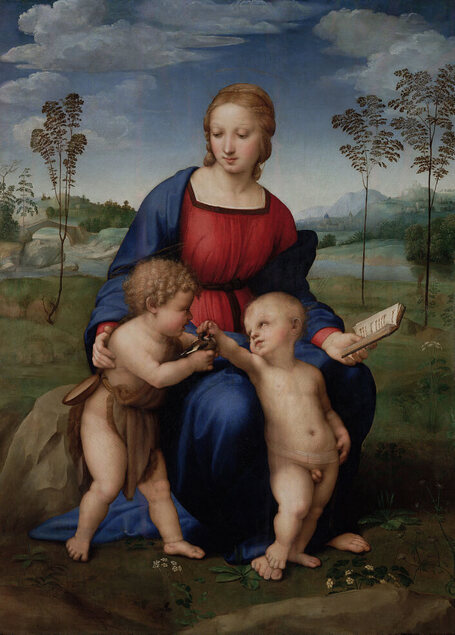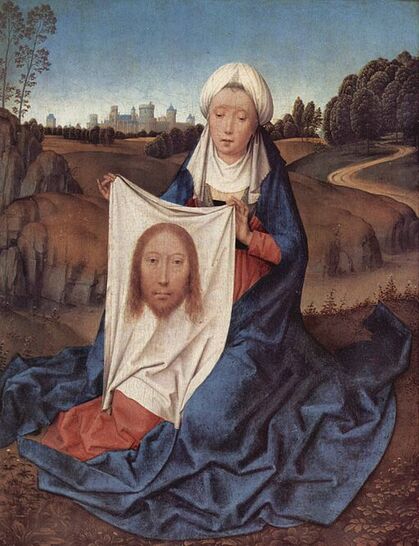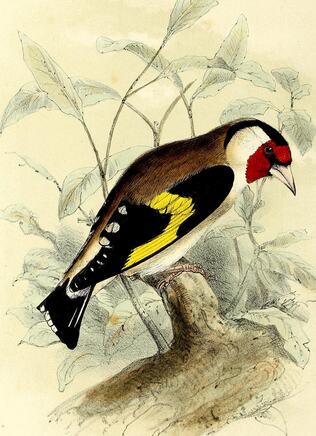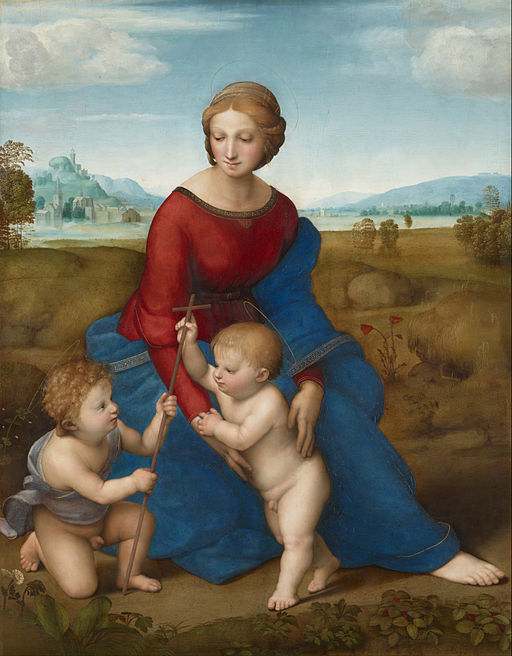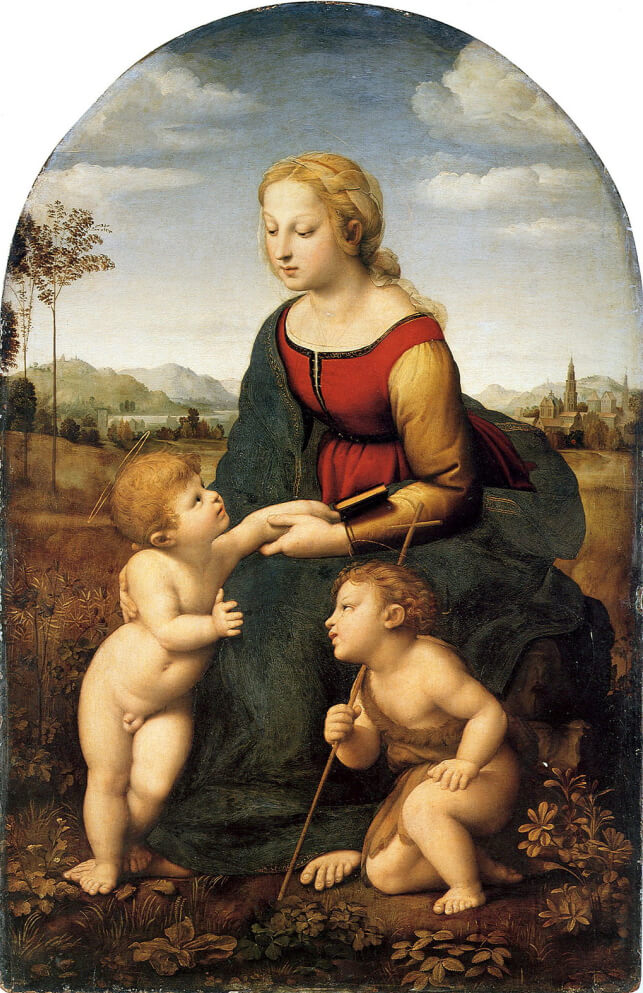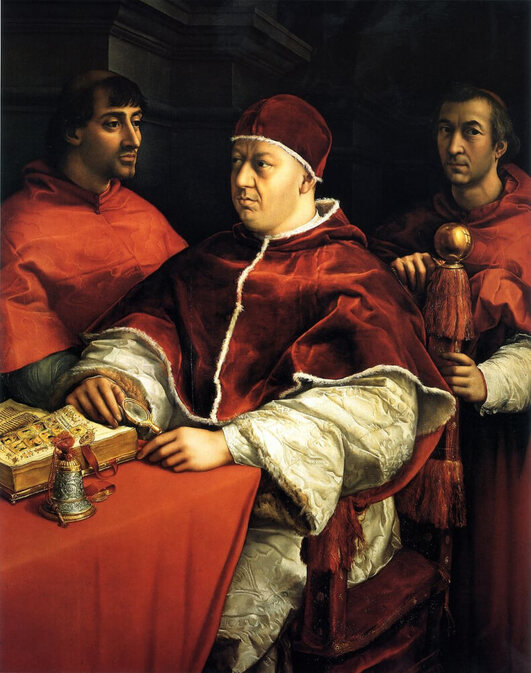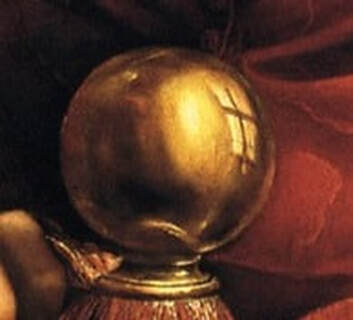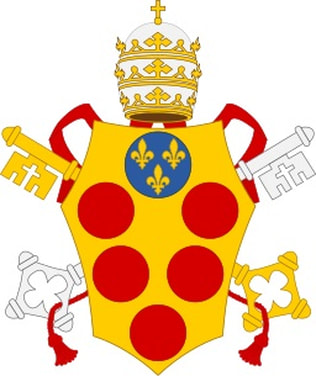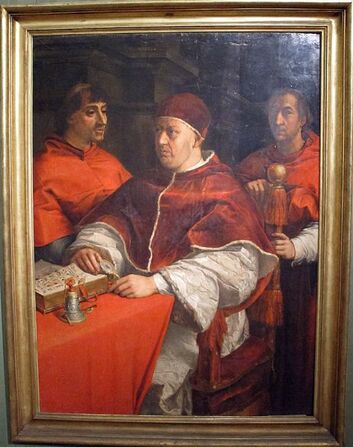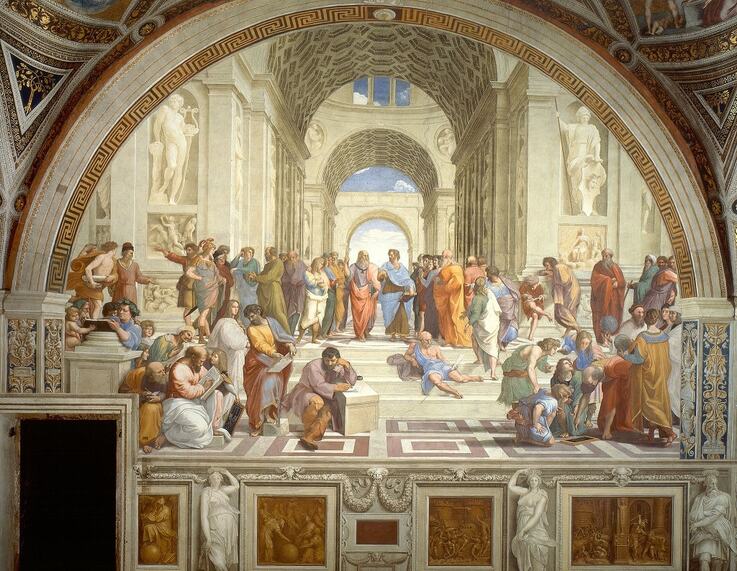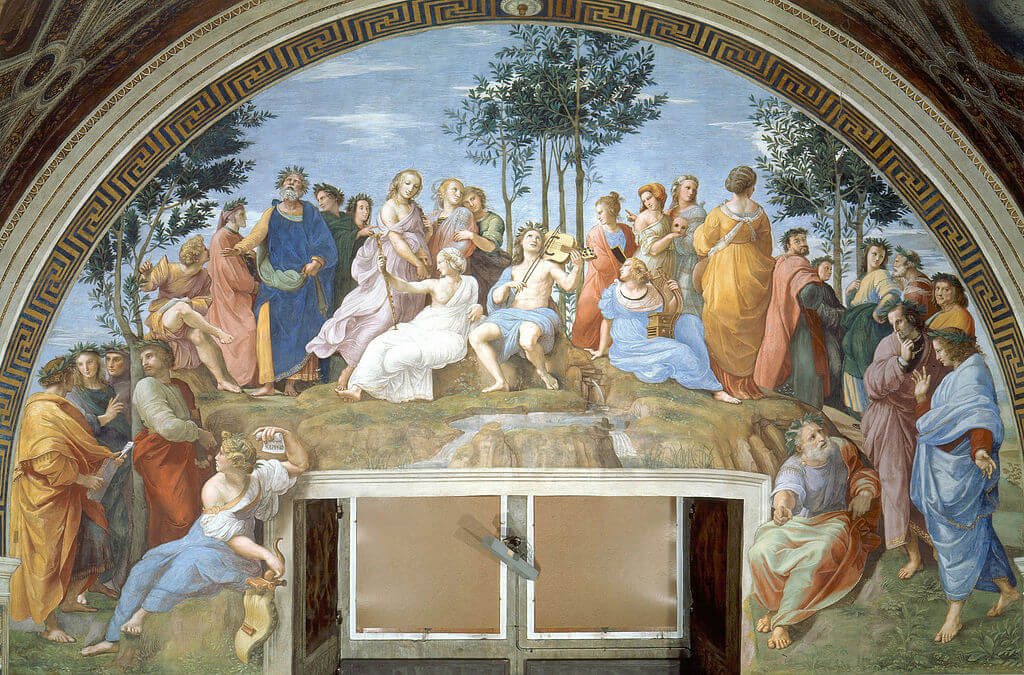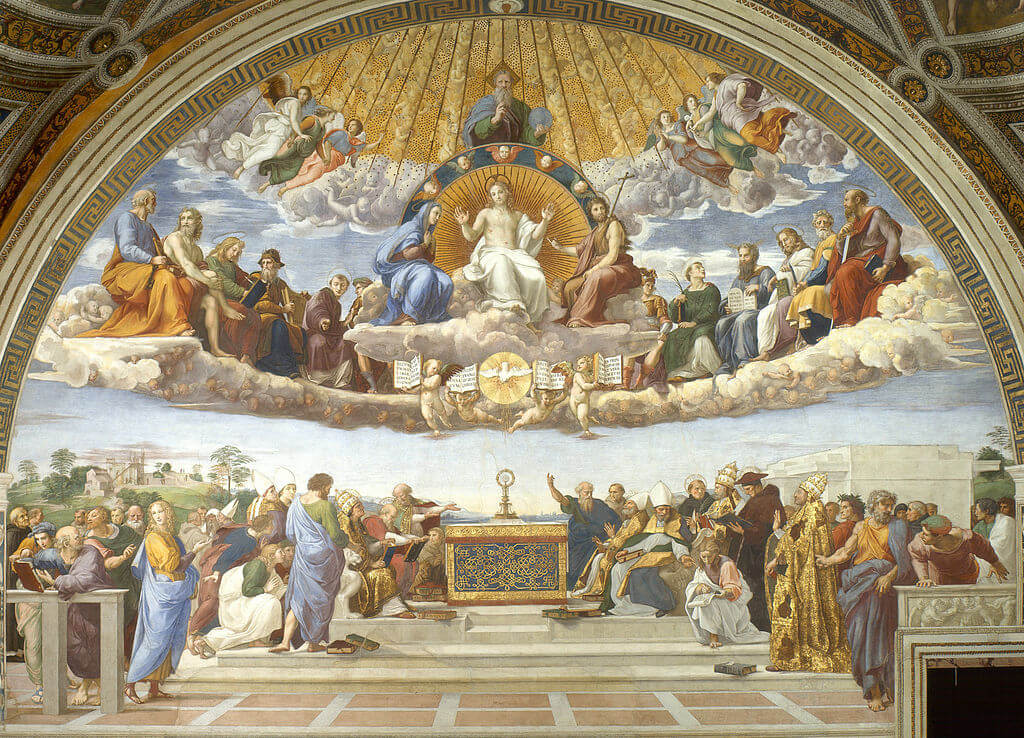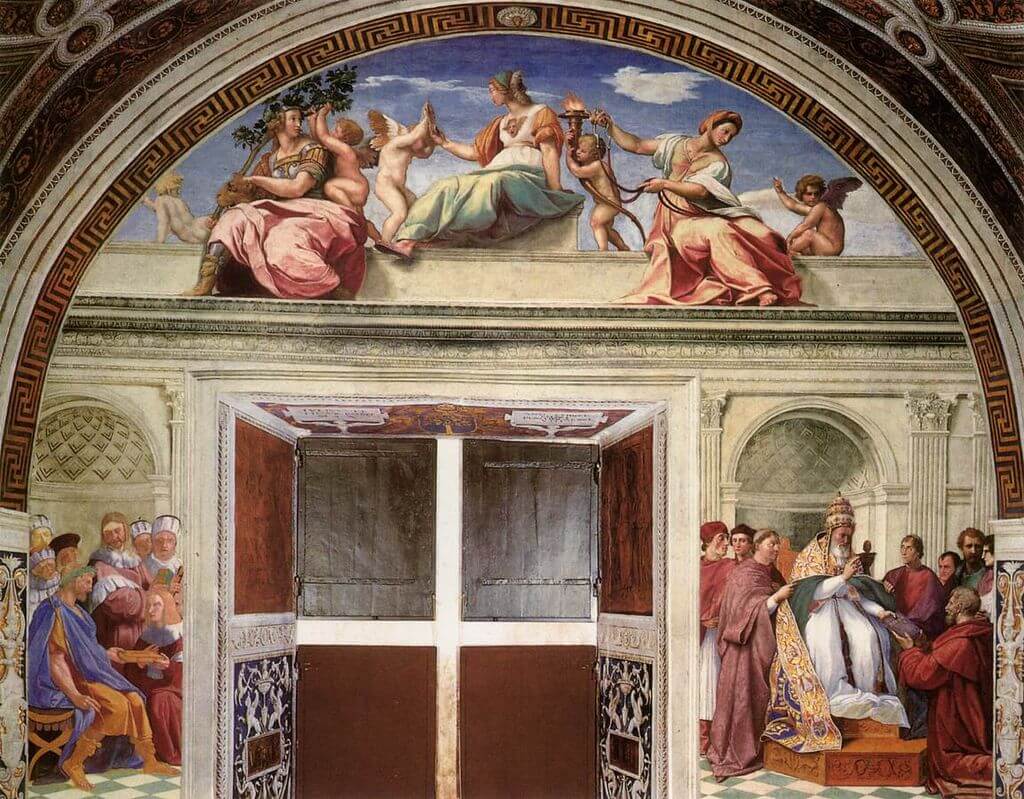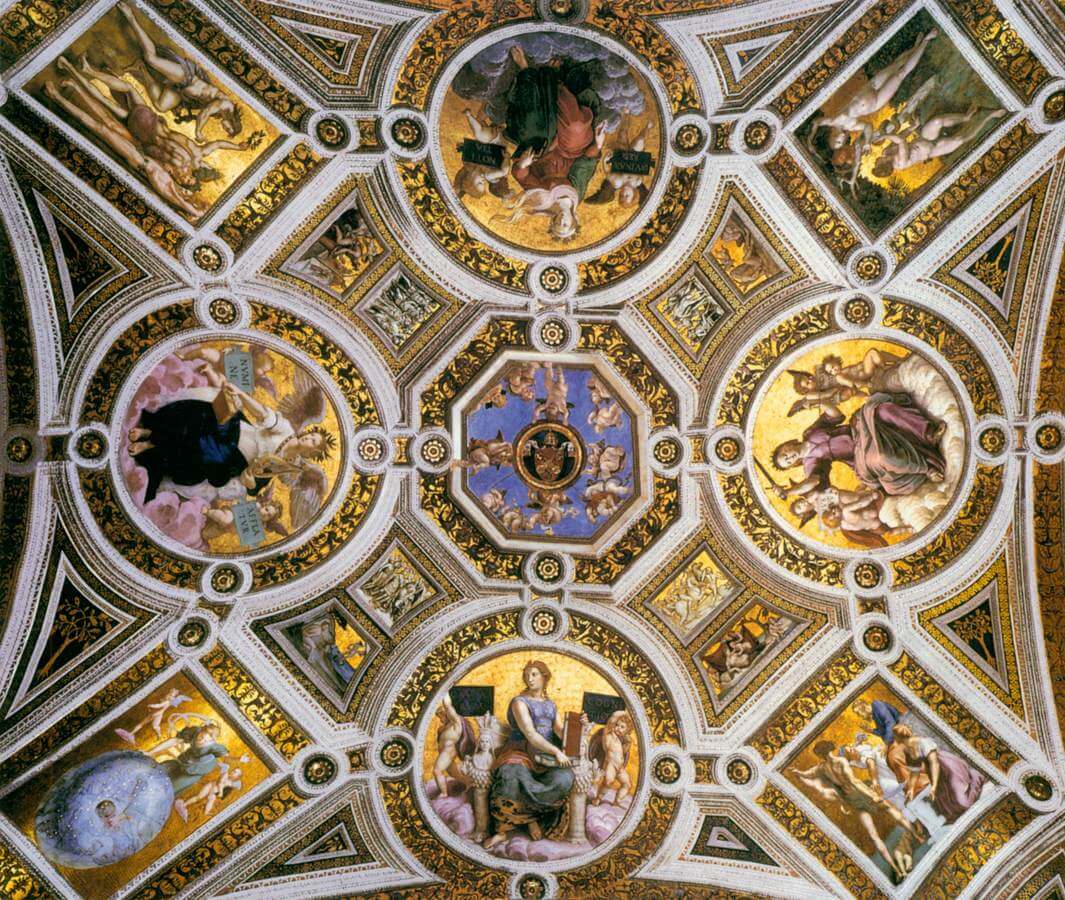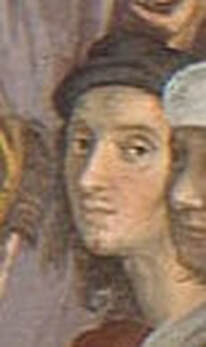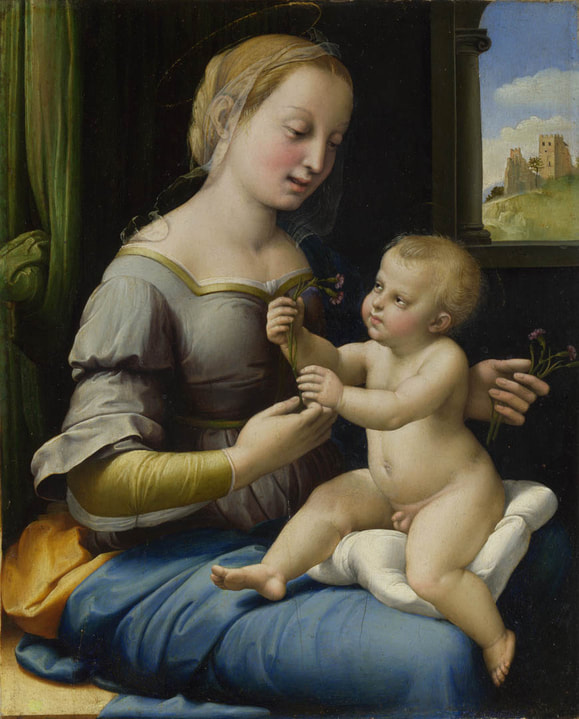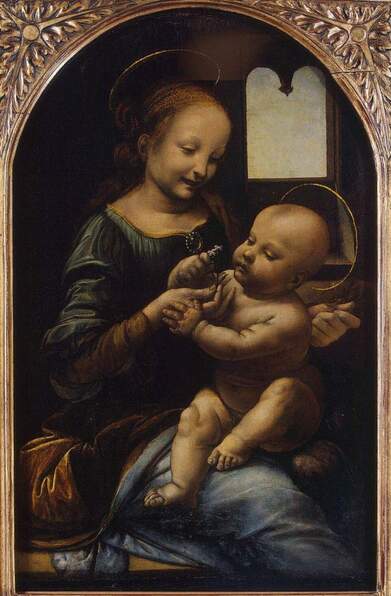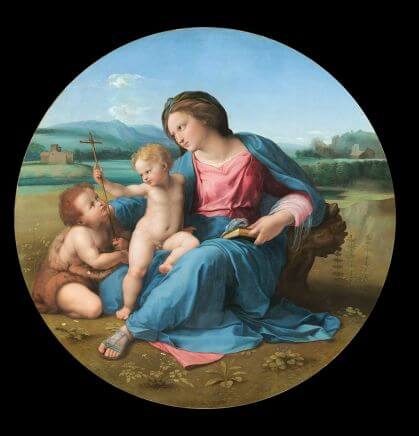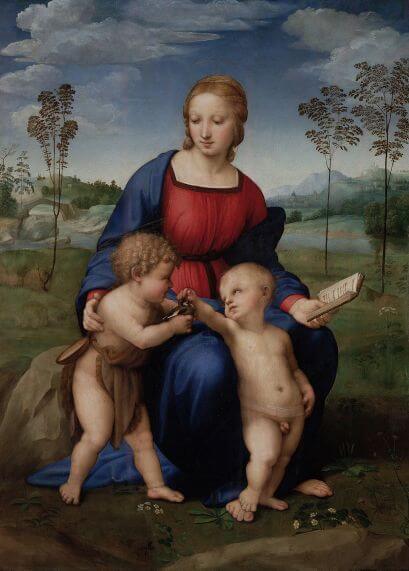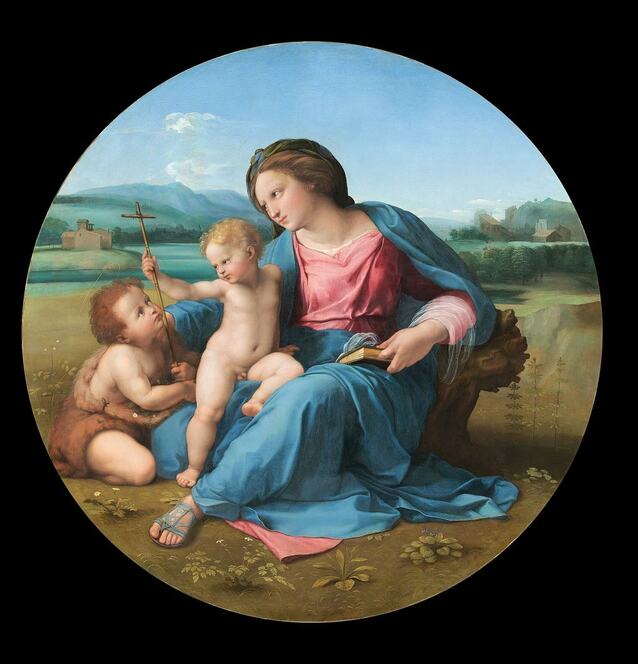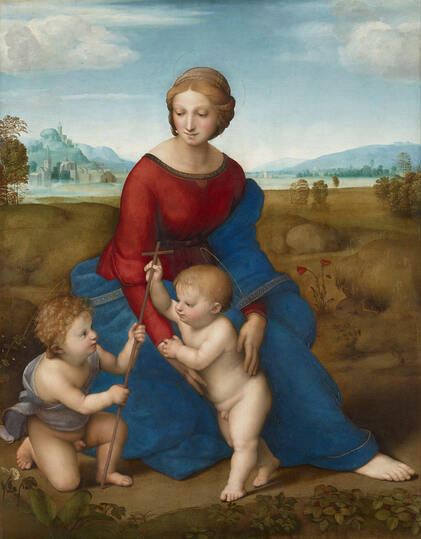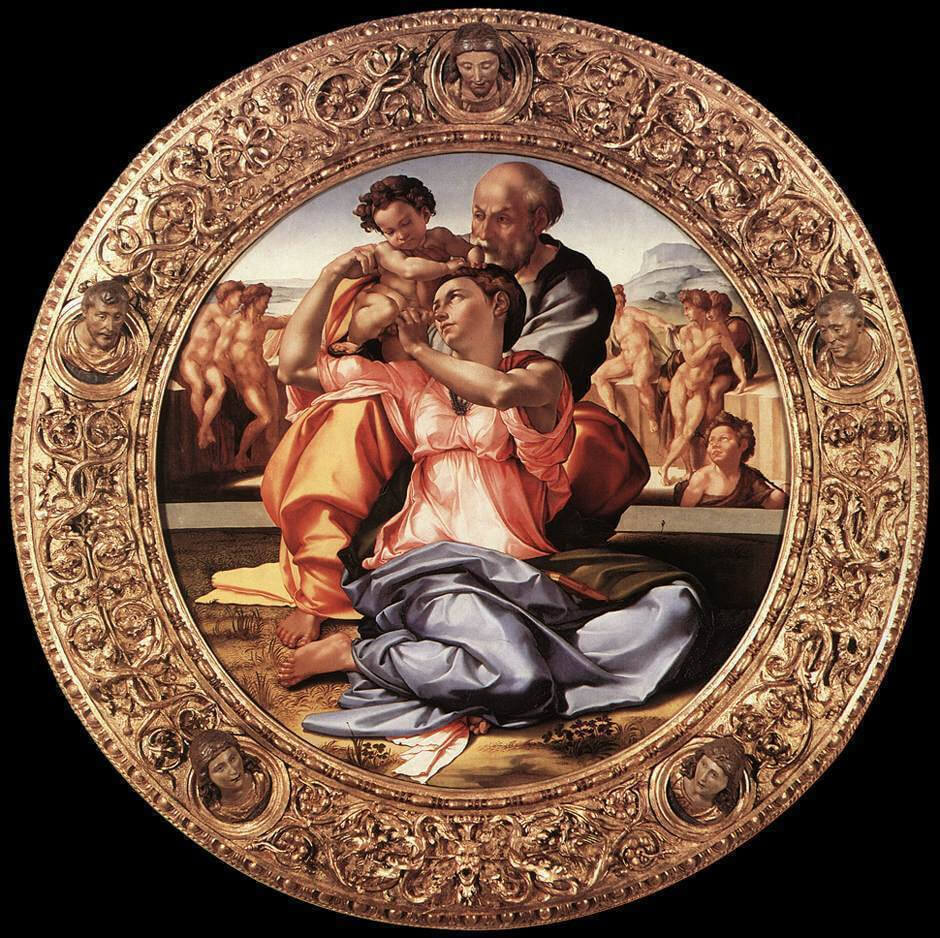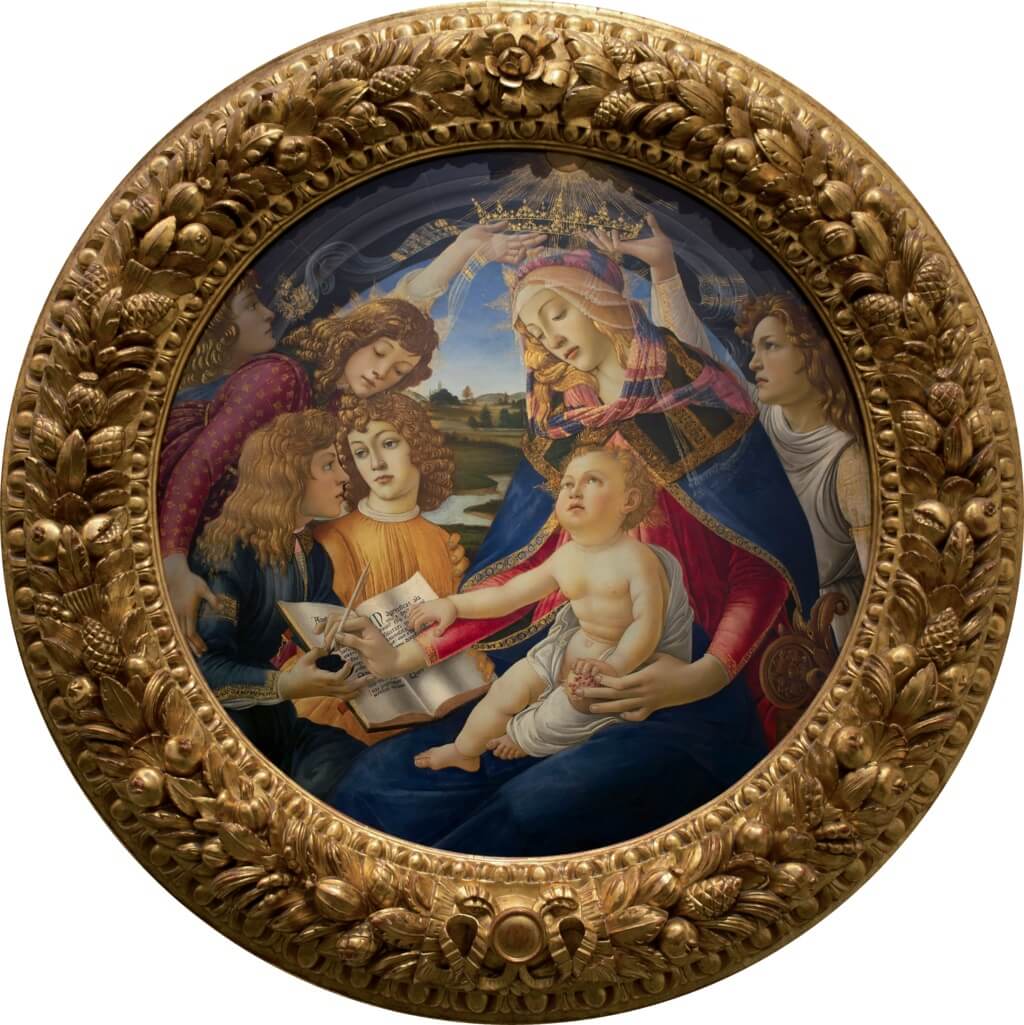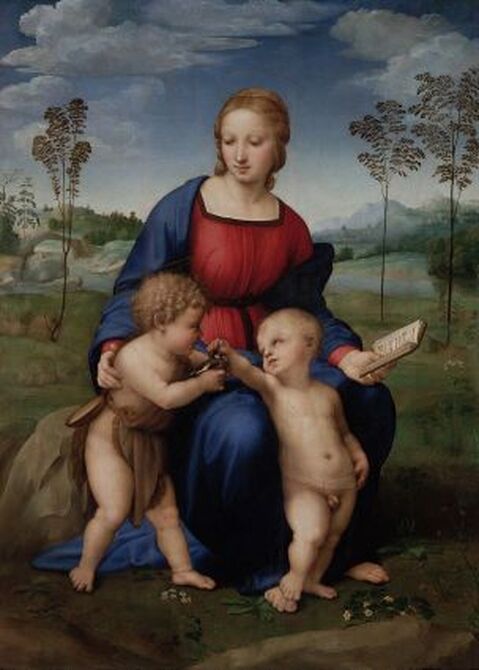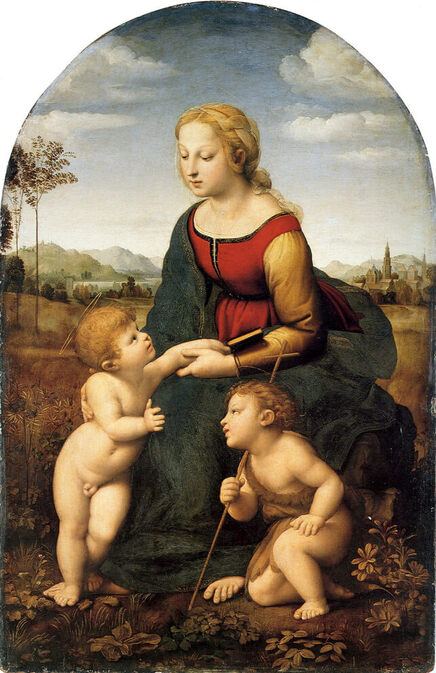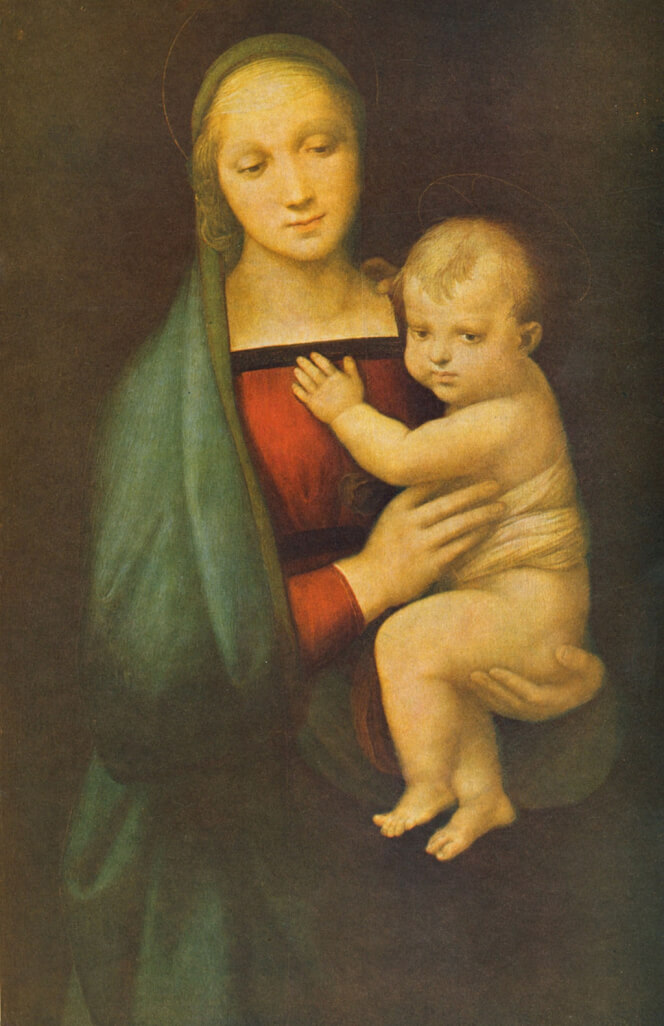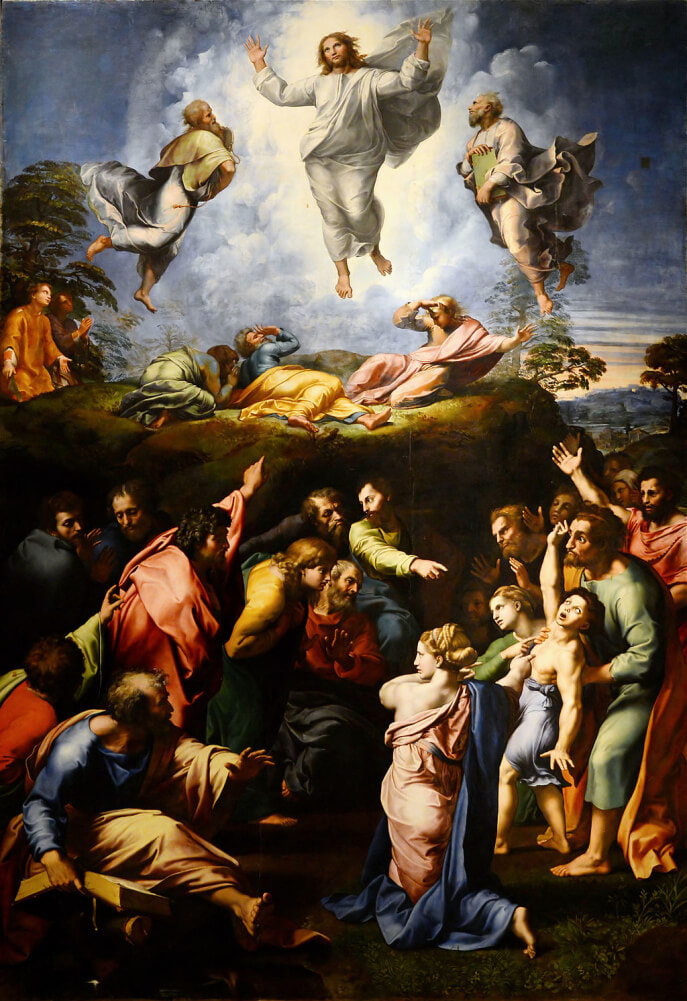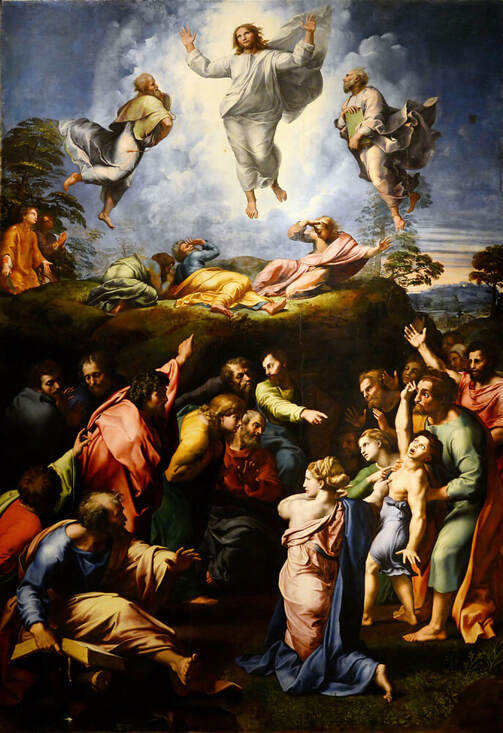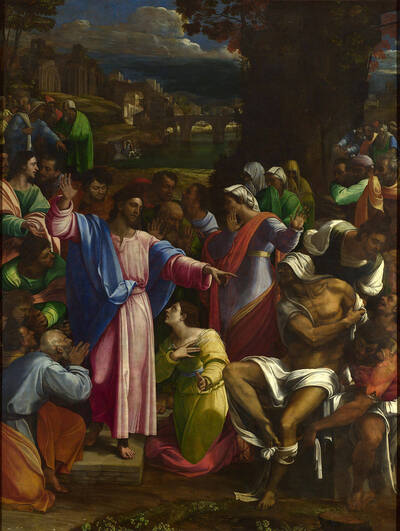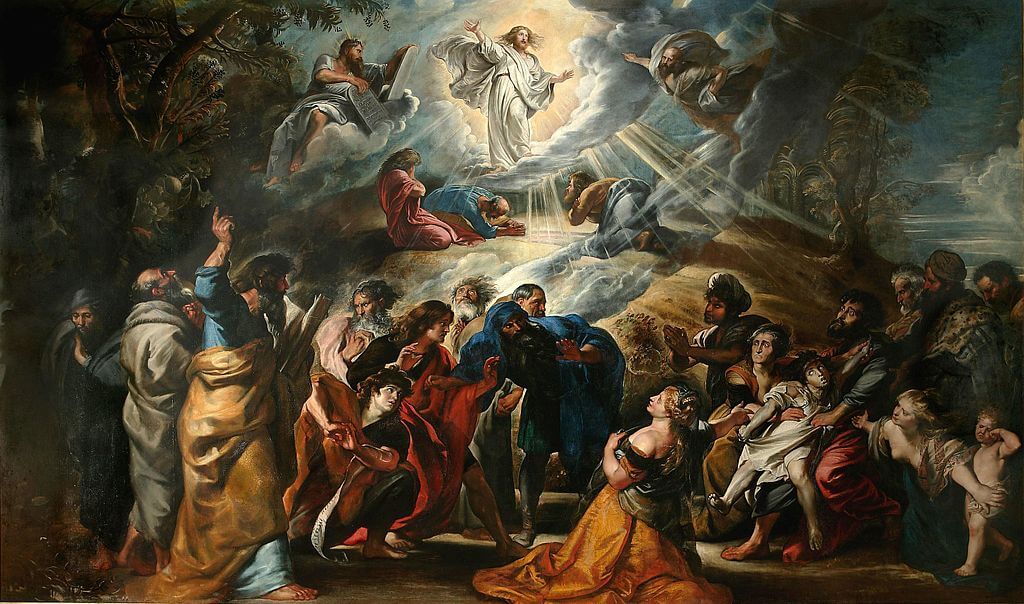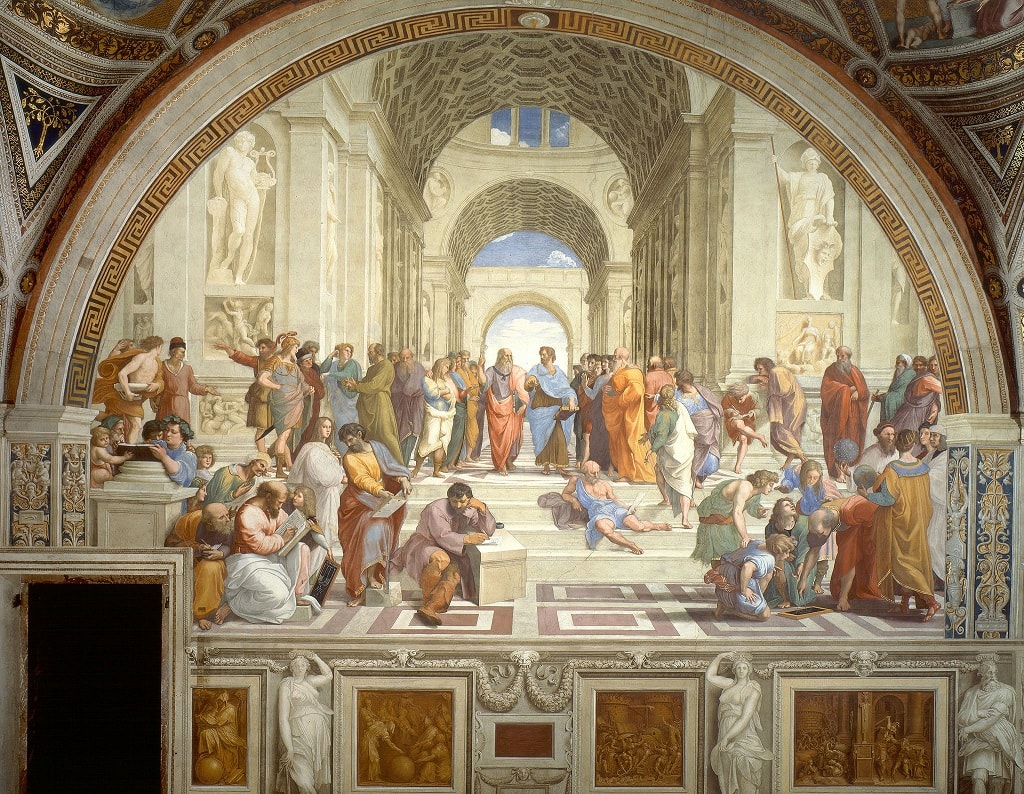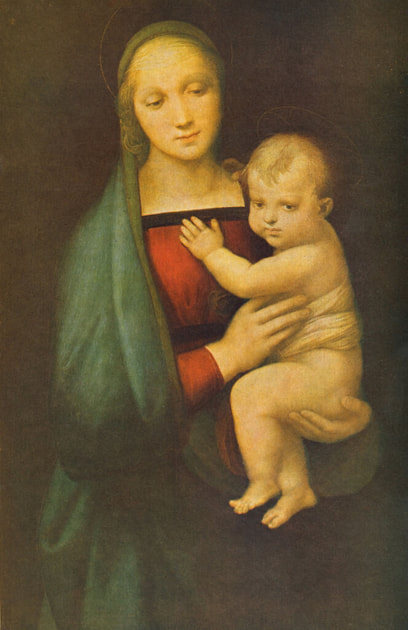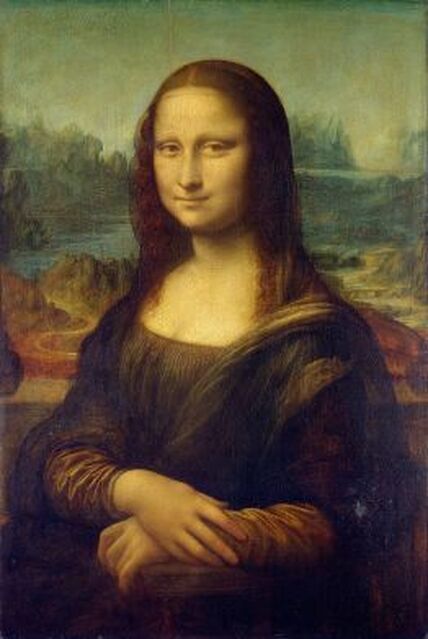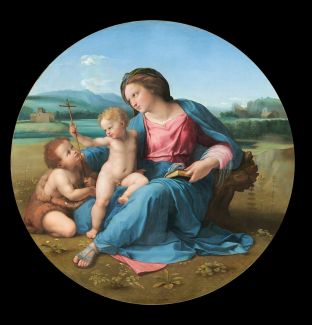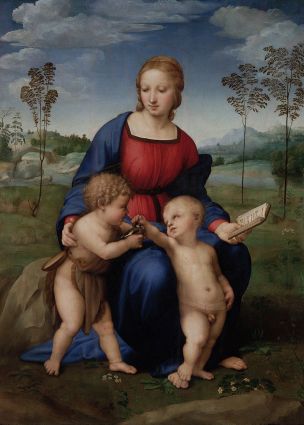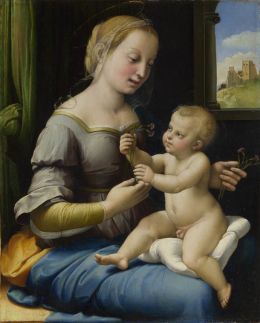|
Where? Room 41 of the Uffizi Museum
When? 1505-1506 Created for? A wedding gift of Raphael to his friend Lorenzo Nasi. What do you see? This painting – also known as Madonna del Cardellino – shows the Virgin Mary (referred to as the Madonna), Jesus, and Saint John. Mary sits on a rock and wears a red dress with a blue mantle on top of it. She protectively watches the two children in front of her. Saint John, the boy on the left with the gold curly hair, is dressed in animal skins. He holds a goldfinch bird in his hand. He wants to give the goldfinch to Jesus who is touching the head of the bird. Jesus is close to his mother and places his foot affectionately on his mother’s foot. The three figures in this painting are shown in a pyramidal form – known as the Renaissance triangle – a popular composition in the early Renaissance to represent symmetry in a painting. In the background, you can see a blue and green landscape with bushes, trees, hills, a river, a bridge, a castle, and some houses. Backstory: Raphael created this work for his close friend Lorenzo Nasi, a wealthy wool merchant from Florence. The painting shows the meeting between Saint John, Jesus, and Mary. This scene is based on a medieval religious text, Meditationes Vitae Christi (see a later translation here), which describes the Holy Family meeting Saint John in the desert on their way back from Egypt (a story not mentioned in the Bible). The composition of the work was directly inspired by the painting Saint Veronica by Hans Memling, which was created between 1470 and 1475. The clothes of Mary, the composition, and the city in the background are all elements that can also be seen in Memling’s painting. Raphael's painting deteriorated severely over time, and in May 1999 it was taken down for restoration. It took almost ten years to finish the restoration. In the meanwhile, a much-lower-quality copy of the painting was on display in the Uffizi Museum.
Symbolism: The Virgin Mary is dressed in red and blue. Red is a symbol of the passion of Christ and blue is the symbol of the Church and of Mary. It was one of the more expensive pigments and therefore appropriate to use for an important figure like Mary.
The European goldfinch is associated with the crucifixion of Jesus. In this painting, Saint John passes the bird on to Jesus as a forewarning of his violent death. From the book that Mary is holding, experts have identified the words “Sedes Sapientiae”. This is one of the devotional titles given to Mary and means “seat of wisdom”. It emphasizes that Mary gave birth to Jesus (who represents wisdom). When Mary is depicted in the role of the “seat of wisdom”, she is typically shown seated on a throne with Jesus in her lap. However, in this case, the rock on which Mary sits serves as the throne. Flowers: Several flowers can be seen in the painting. While not all flowers have been identified conclusively, many believe the flowers to be: anemones (representing Mary’s sorrow for the passion of Jesus), daisies (representing the innocence of Baby Jesus), plantains (representing the path to follow Jesus), and violets (representing humility).
Who is Raphael? Raffaello Sanzio da Urbino (1483-1520), popularly known as Raphael, was born in Urbino, a small city a few hours east of Florence. Together with Michelangelo and Leonardo da Vinci, he is considered one of the great masters of the Renaissance. He was a very talented architect, drawer, and painter, but is best known for his paintings of the Virgin Mary (called Madonnas) and his large-scale depictions of humans.
The Madonna of the Goldfinch was created during Raphael's period in Florence and shares many similarities with two other paintings of Raphael: the Madonna of the Meadow in the Kunsthistorisches Museum in Vienna and La Belle Jardinière in the Louvre. A few years later, in 1508, he moved to Rome where he completed many works for the Pope, such as the Portrait of Leo X with Two Cardinals.
Fun fact: IIn 1547, the house of the Nasi family, which was several feet away from the Ponte Vecchio, collapsed. Two of the occupants were killed and much of its decorations got damaged. Raphael's painting was also badly damaged. Battista Nasi, the son of Lorenzo Nasi, did all he could to retrieve the remainings of this painting as it was a very valuable asset of his father.
The painting had broken into six large pieces and even more smaller pieces. Battista could recover most pieces, except one large piece from the bottom left corner. The painting was restored by Ridolfo del Ghirlandaio, a good friend of Raphael. He did a great job in restoring the painting as this painting has become a very popular part of the Uffizi collection over the next centuries. Interested in a copy for yourself? Poster or canvas
2 Comments
Where? Room 41 of the Uffizi Museum
When? 1517-1519 Commissioned by? Pope Leo X What do you see? The portrait of Pope Leo X, shows the Pope sitting in his study. He is depicted realistically in a three-quarter profile. He wears the papal robe and the papal camauro, a cap traditionally worn by the pope. A cardinal is on both sides of him. Their silence helps to establish the authority of Pope Leo X in this painting. All three are wearing velvet (a woven fabric with evenly distributed patterns), and the Pope is also wearing a so-called, damask undergarment that shines in the light and has fur linings.
Backstory: Raphael was the lead painter for Pope Leo X and he had already made quite some portraits of Pope Leo X in fresco scenes. He also painted several portraits of Leo X to distribute throughout Italy. The current painting is the most well-known of these different portraits. The idea behind distributing these paintings was to promote the Medici regime throughout the country. This was important as a lot of things were happening in those years that created uncertainty for the common people and their leaders. One of these things was that Martin Luther (a famous German theology professor) publicized his famous list of complaints against the Roman Catholic Church.
Between 1513 and 1605, four popes came from the Medici family. An important reason for this is that popes liked to appoint their family members as cardinals, making it more likely that they would eventually become pope. The cardinal on the left of the painting is Giulio di Giuliano de’ Medici (a cousin of the Pope who would become Pope Clement VII from 1523 until 1534). The cardinal on the right is Luigi de’ Rossi (another cousin of the Pope).
Who is Pope Leo X? Giovanni de’ Medici (1475 – 1521) is the second son of Lorenzo the Magnificent, the ruler of the Florentine Republic. He became a cardinal at 13 years old. An important reason that Giovanni became a cardinal at such a young age was that his sister was married to Pope Innocent VIII. He became pope on March 9, 1513, until his death on December 1, 1521.
During his rule as pope, Leo X excommunicated Martin Luther from the church, and he granted people who donated to the reconstruction of St. Peter’s Basilica a reduction in the amount of punishment they would have to undergo for their sins (called indulgence). He was a big spender and ruined the papal finances under the motto: “Since God has given us the papacy, let us enjoy it”. Who is Raphael? Raffaello Sanzio da Urbino (1483-1520), popularly known as Raphael, was born in Urbino, a small city a few hours east of Florence. His father, Giovanni Santi, was a painter with a good reputation, but Raphael had already lost both his parents at age 11. Raphael is best known for his depictions of the Virgin Mary (Madonnas), and his large-scale depictions of humans. His work is widely appreciated for the clarity and magnificence with which he could paint people and his simple compositions. In 1508, he was summoned to Rome by Pope Julius II, the predecessor of Pope Leo X, to become the lead court painter. He stayed there until his death, which was one year before the death of Pope Leo X. He is buried in the Pantheon in Rome.
Where? Stanza della Segnatura (one of the four Raphael Rooms) in the Vatican Museums
When? Between 1508 and 1511 Commissioned by? Pope Julius II What do you see? 58 different philosophers are gathered on a sunny day in a beautiful palace-like building. The philosophers are busy with a variety of activities such as reading, writing, listening, arguing, explaining, etc. In the center of the fresco, under the arch, you can see two of the most famous philosophers both holding a book: Plato (with the red robe) is on the left and Aristotle (with the blue robe) is on the right. These two philosophers had different philosophical views. Besides them, two rows of philosophers are following their conversation. Several figures to the left of Plato, you can see a figure in a completely green robe. This figure is Socrates. You can see four to five people who are listening to his story. In front of Aristotle, you can see Diogenes, a half-naked man dressed in blue sitting on the stairs. In the right foreground, a group of nine philosophers is busy with geometry and astronomy. Five people are looking at a geometrical problem and Euclid or Archimedes (art historians are not sure who of the two it is) is using a compass to explain the problem on the board on the floor. Four others are talking about astronomy. Ptolemy is holding a scale model of the earth, and Zoroaster is holding a scale model of the stars in the sky. In the left foreground, you can see a group of philosophers with Pythagoras in the middle. Pythagoras is writing in a book, and someone else is holding a board in front of him with a drawing of Pythagorean harmonics (which is a combination of music and arithmetic). Somewhat to the right of this group is a man sitting by himself writing some notes. This man is Heraclitus and his position is in line with the lonely life he lived. The person in the blue robe writing in a book on the left in the foreground is Epicurus. Statues: There are two large statues in the fresco. The one on the top left is Apollo. You can recognize him by the lyre he is holding in his role as the god of music. The goddess on the top right is Athena. In her role as the goddess of war, she is holding a very long spear in her right hand, and she is holding a shield with the head of Medusa in her left hand. Backstory: The Stanza della Segnatura was designed to function as the library of Pope Julius II. The idea was to organize the books of the pope in four categories: law, philosophy, poetry, and theology. The fresco of the School of Athens is full of ancient philosophers and thus represents the philosophy theme. The philosophers come from different time periods, and several of them have never met each other. For example, Pythagoras lived in the 6th century B.C., Socrates in the 5th century B.C., and Aristotle in the 4th century B.C. The philosophers are also not all from Athens, but in fact from quite some different countries. For example, the man with the turban and the green robe who is leaning over Pythagoras is Averroes. He is an Islamic philosopher who was born in Spain in the 12 century A.D. What is the Stanza della Segnatura? The Stanza della Segnatura (Room of the Signatura) is one of the four Raphael Rooms. This room was the library of Pope Julius II. Raphael painted everything in this room. When standing with your face towards the School of Athens, the wall on the left displays a fresco named The Parnassus (which represents poetry). The wall on the right displays Cardinal and Theological Values (representing justice). The wall opposite the School of Athens displays the Disputation of the Holy Sacrament (representing theology). On the arched ceiling, you can see four circular frescos of a female on a throne. The female above the School of Athens represents Dame Philosophy, and she was used in the Middle Ages as an allegory to philosophy.
Who are Plato and Aristotle? Plato and Aristotle are two of the most influential philosophers the world has known. Plato was a student of Socrates and Aristotle was a student of Plato. In the fresco of Raphael, Plato is holding a book entitled Timaeus (which describes the origins of the world), and Aristotle is holding a book entitled Ethics.
Plato believed in an ultimate reality that was beyond what we observe in this world, and that is why you can see him pointing upwards to the sky. In contrast, Aristotle believed that the world in which we live and what we observe is the ultimate reality and he is, therefore, pointing forward into the world. Who is Raphael? Raffaello Sanzio da Urbino (1483-1520), better known as Raphael, was one of the three great painters of his time (the others being Leonardo da Vinci and Michelangelo). In 1508, Pope Julius II invited him to Rome where he lived until his death. In 1508 he was asked to paint the Stanza della Signatura for Pope Julius II. This was the biggest commission so far in his career, and after he completed this room, he was asked also to paint three other rooms (which are now collectively known as the Raphael Rooms).
Where? Room 60 of the National Gallery
When? 1506-1508 Commissioned by? Probably the Oddi family, a prominent family from Perugia. What do you see? The young Virgin Mary is sitting on a yellow-brown bench with Baby Jesus on her lap and you can see the faint halos above their heads. Mary looks at Jesus and is playing with him. She holds two flowers in her left hand and in her right hand she holds another flower which Baby Jesus is examining. The flowers are identified as pink carnations (also referred to as pinks). Jesus is sitting on top of a white cushion and is absorbed by the flower. Mary is wearing a greyish dress with a belt, and her dress is yellow-gold and white on the top and on her right arm. She also has a blue robe around her legs, and this robe also covers her left side including her shoulder (this is a bit more difficult to see as this blue has darkened a bit over time). She is also wearing a transparent veil in her hair that falls over her shoulders. On the top right, you can look through the window and observe the hills, a castle, and the blue skies. On the left, you can see a green bedcurtain. Note also the quality of Raphael’s work. He carefully combined light and shadow to paint the folds in Mary’s dress and the bodies of Mary and Jesus. His delicate depiction of the translucent veil is also of very high quality. Backstory: This painting is also referred to as La Madonna dei Garofani (which is Italian for ‘The Madonna of the Carnation’) or the Northumberland Madonna (after its previous owner). It is heavily inspired by the Benois Madonna painting by Leonardo da Vinci which can be admired in the Hermitage Museum in Saint Petersburg. The Madonna of the Pinks is a small painting (27.9 cm × 22.4 cm or 11.0 in × 8.8 in), and it may have been created for the nun Maddalena degli Oddi to bring with her wherever she went as an aid for prayer. There are many copies of this painting which are clearly not made by Raphael. However, in 1992, the Duke of Northumberland agreed that the version he owned would be displayed in the National Gallery and could be cleaned and investigated using infra-red reflectography. The investigation concluded that this painting was the original made by Raphael (though some experts still doubt this attribution nowadays). The painting is still in excellent condition, but some cracks can be seen. For example, in the bottom middle, there is a clear vertical crack that runs up through the right leg of Jesus and the back of Mary’s right hand.
Symbolism: The main symbol in this painting is the pink carnation (or pink). According to a legend, this flower first appeared on earth from the tears of Mary that fell on the cross at the crucifixion of Jesus. Pink carnations symbolize the divine love of Mary towards Baby Jesus. They are also seen as a symbol of divine protection and marriage. The pink carnation is still a popular flower for Mother’s Day in the U.S.
The scene of Mary and Jesus is situated in a bedchamber, which is a symbol of maternity. Furthermore, the castle towers seem ruined, which is a symbol of the demise of the pagan world after the birth of Jesus. Who is Raphael? Raffaello Sanzio da Urbino (1483-1520) was born in Urbino in Italy. Together with Leonardo da Vinci and Michelangelo, he is considered to be one of the three prime painters of his time. He moved to Florence in 1504 where he created this painting. During that time he primarily created Madonnas and portraits. In 1508 Raphael moved to Rome to work for the Pope. Raphael often included the Madonna theme in his paintings. For example, the Alba Madonna in the National Gallery of Art in Washington, DC shows Mary, Jesus, and Saint John. Another example is the Madonna of the Goldfinch in the Uffizi Museum in Florence, which also shows Mary, Jesus, and Saint John.
Fun fact: The painting was acquired by the National Gallery in 2004 for almost ₤35 million (which was equivalent to about $60 million at that time). Given its small size, this painting became the most expensive painting ever sold per square centimeter. The acquisition of this painting was not easy, however, as the National Gallery and the J. Paul Getty Museum in Los Angeles were fighting a public battle over this painting.
Both museums were willing to offer an equal amount of money for the painting. However, the National Gallery came up with some very favorable tax advantages for the seller, who was the Duke of Northumberland and thus lived in England. Interestingly, when the painting was discovered in the collection of the Duke in 1991, it was considered a copy of Raphael’s original painting that was missing and only valued at ₤6000.
Where? Gallery 20 of the National Gallery of Art
When? 1510-1511 Commissioned by? Probably Paolo Giovio, though it could also have been Pope Julius II. What do you see? The beautiful Mary sits on a tree trunk with her son Jesus on her right leg, and Saint John sits next to them on the ground. Mary is dressed in a pink and blue dress, Saint John in a fur robe, and Jesus is naked. Mary is holding a prayer book in her left hand. She looks at the cross that Saint John seems to hand to Jesus. Saint John looks at Jesus and Mary, while Jesus looks at Saint John. Their gazes seem somewhat sad as if they are thinking about what is going to happen to Jesus at the end of his earthly life. Notice the index finger of Jesus that is pointing upwards to God while he receives the cross. Saint John holds some flowers, including anemones and white dandelions. The painting is very peaceful with a calm sky, and the trio is surrounded by flowers, including cyclamen (to the left of Saint John), blue violets (in the left foreground), and lady’s bedstraw (the tall plants on the right). The landscape is probably inspired by the Tiber valley near Rome. Backstory: Raphael painted this work while he was in Rome, at the same time that he worked on the famous Raphael Rooms in the Vatican Museums. It is most likely that this painting was commissioned by Paolo Giovio and gifted to the church of the Olivetani in Nocera dei Pagani when he was appointed a bishop there. However, some people also argue that it could have been commissioned by Pope Julius II who Raphael was working for in 1510. The name of the painting, Alba Madonna, is given because the painting was owned by the aristocratic Spanish House of Alba during the 18th century. As Raphael painted many Madonna-themed paintings, this name differentiates it from the others.
Tondos? This painting of Raphael is a so-called tondo. A tondo is used to refer to a circular painting over two feet (60 cm) in diameter. The word ‘tondo’ is derived from the Italian word ‘rotondo’, which means round. A tondo helps the viewer to focus on the center of the painting. The circular shape is also perceived to be an ideal and infinite shape. These are the reasons that the tondo was often used for Madonnas as the focus of those paintings had to be on Mary and Jesus. You can also see in this painting that the composition of Mary, Jesus, and Saint John is quite circular.
The tondo format was mainly popular in the 15th and 16th century and has been used by painters such as Botticelli, Michelangelo, and Raphael. One of the most well-known tondos is the Doni Tondo by Michelangelo in the Uffizi Museum in Florence. Another example is the Madonna of the Magnificat by Botticelli which is also in the Uffizi.
Fun fact: Raphael has created many religious paintings during his career, and especially many Madonnas. However, Raphael did not always live like a religious person. In fact, rumors are that he had many affairs with women while he was in Rome. In 1514 he got engaged to Maria Bibbiena, but he never married her.
Vasari also writes in his book that Raphael died (which may have been on his birthday) after a night of excessive sex. After the wild night he got sick but did not want to tell the doctors the cause of it. As a result, they did not provide him with the right treatment and he died.
Where? First floor, room 710 of the Denon wing in the Louvre
When? 1507 or 1508 Commissioned by? Fabrizio Sergardi, a nobleman from Siena, Italy. What do you see? The young Virgin Mary sits on a rock. She wears a red dress with golden sleeves, a dark blue mantle on top of that, and a veil around her head. She holds Baby Jesus with her hands and looks down affectionately at him. Saint John the Baptist is the boy to the right of Jesus. Baby Jesus reaches out with his left hand to grab the book that Mary holds. He looks up to his mother with a loving expression, asking her to read the book to him. The left foot of Jesus stands on top of Mary’s right foot. The position of Jesus is similar to the one in the Madonna statue by Michelangelo – created between 1501 and 1504 – in the Onze Lieve Vrouwenkerk in Bruges. Saint John the Baptist holds a reed cross in his right hand and wears a camel skin. He looks at Jesus with an adoring gaze. All three figures have a faint halo above their head. In the foreground is a beautiful garden with several plants and flowers, including violets, columbines, anemones, and dandelion leaves. In the background is a lake with mountains, some bushes and trees, and on the top right is a village.
Backstory: La Belle Jardinière means ‘the beautiful gardener’ and refers to the plants that surround the trio in this work. This painting is also known as Madonna and Child with Saint John the Baptist. This scene is based on a story in the book, Meditationes vitae Christi, in which the family of Jesus visits Saint John the Baptist on their way back from Egypt.
There is some speculation, based on the art history book by Vasari, that Raphael did not finish the painting. Vasari suggests that Ridolfo Ghirlandaio finished the last parts of this painting (to be precise, the blue mantle of Mary). Evidence against this claim is that Raphael signed and dated this painting in the mantle of Mary, suggesting that he finished it himself. This painting was commissioned by Fabrizio Sergardi who sold it later to Francis I, King of France. The pyramidal composition of this painting is very similar to two earlier Madonna paintings by Raphael: Madonna of the Goldfinch in the Uffizi Museum (1505-1506) and Madonna of the Meadow (1506) in the Kunsthistorisches Museum in Vienna.
Symbolism: The red dress of Mary symbolized the Passion of Christ and her blue mantle refers to the Church, which is the link between Mary and the crucifixion of Jesus. The book that Mary holds contains the story of the life of Jesus including the crucifixion.
While Saint John the Baptist is older than Jesus, he sits on one knee such that he is positioned lower than Jesus. This positioning indicates that Jesus is above Saint John the Baptist in the Christian hierarchy. Saint John the Baptist is holding a reed cross which refers to the sacrifice that Jesus will make at the end of his life by dying for the sins of humanity. The reed cross and the camel skin are typical symbols associated with Saint John the Baptist. The violets in the right foreground are a symbol of the humility of the Virgin Mary. The columbines to the left of Jesus refer to the future sacrifice of Jesus. Who is Raphael? Raffaello Sanzio was born in 1483 in Urbino, less than 100 miles east of Florence. Between 1504 and 1508, Raphael worked primarily in Florence where he created multiple Madonna paintings, including the Madonna of the Goldfinch in the Uffizi Museum, Madonna of the Grand Duke in the Palazzo Pitti, Madonna of the Pinks in the National Gallery, and the Alba Madonna in the National Gallery of Art. In 1508, Raphael moved to Rome to work for the Pope. He stayed there until his death in 1520. His last painting was the Transfiguration which is now in the Vatican Museums. His works are often characterized as soft and sweet. He achieved the softness by using the sfumato technique, which he learned from Leonardo da Vinci. This technique mixes different colors in the painting to create soft transitions between different objects. The sweetness is achieved by the harmony in Raphael’s compositions. For example, in this painting he used a triangular composition, where the figures are neatly balanced in space.
Fun fact: There is some debate about whether this painting is the original one painted by Raphael. As Raphael’s painting was well-received, over time, many great painters, including Eugène Delacroix, have copied the painting. Therefore, many replicas of the painting exist. These copies have also spurred the debate on which version is the real Raphael. Another reason for the debate is that the whereabouts of this painting are somewhat uncertain between the 16th and 18th century.
A recent claim for the original was made in 2014 by the Swiss lawyer Hanspeter Sigg. He is in possession of a painting entitled, Madonna Leo X. This is a painting by Raphael that is very similar to La Belle Jardinière. Raphael painted this work in 1513 for Pope Leo X. Sigg, however, claims that La Belle Jardinière is a replica of his painting and that he owns the original. Until now, there is a lack of support for this claim and Le Belle Jardinière in the Louvre remains the original.
Where? Room 8 of the Pinacoteca in the Vatican Museums
When? 1516-1520 Commissioned by? Archbishop Giulio de’ Medici (who later became Pope Clement VII) for a chapel in the Narbonne Cathedral in Narbonne, France. What do you see? Two unrelated biblical events. On top is the story of the transfiguration of Christ. At the bottom is the story of a young man who is possessed by a demon.
In 1523, the painting was placed in the San Pietro in Montorio Church in Rome. Over the centuries, numerous artists and art experts considered this to be the best painting ever.
Biblical stories: The story on top is the transfiguration and on the bottom is The Healing of the Lunatic Boy. Both stories are described in Matthew 17, Mark 9, and Luke 9. The biblical story describes how Jesus is transfigured in radiant glory when praying with three of his disciples on a mountain. Jesus speaks with Moses and Elijah and also hears the voice of God. The Feast of the Transfiguration is still celebrated in many churches, either on August 6 or August 19.
The story of the demon-possessed boy occurs at the same time as the transfiguration. When Jesus and his three disciples came down from the mountain, the father of the boy kneels down in front of Jesus and asks him to heal his son as the disciples were unable to do that. In 1605, Peter Paul Rubens painted a variation of the Transfiguration.
Symbolism: The transfiguration shows the connection that Jesus provides between Heaven and Earth and that people should follow the lessons provided by the Son of God. To emphasize this, Jesus is looking upwards to the sky to remind us that he provides the connection between the people on earth and God in Heaven. The three disciples on the mountain represent faith, hope, and love. The scene at the bottom half of the painting symbolizes the inability of people to do miracles without the trust in God's abilities.
Who is Raphael? Raffaello Sanzio da Urbino (1483-1520) was a very productive painter. Despite his short life, he completed many works. Together with Leonardo da Vinci and Michelangelo, he is considered to be the most influential painter of his time. The Transfiguration is considered to be one of Raphael's best works, only surpassed according to some by his fresco of the School of Athens, which is also in the Vatican Museums. The Transfiguration was ahead of its time. It contains some elements of both the Mannerism and Baroque style of painting, and it has had a big influence on the development of both styles. With such a masterpiece, it was a pity that Raphael died on Good Friday 1520. The painting of the Transfiguration was exposed next to the body of Raphael in the days after his death, and it was initially placed above his tomb in the Pantheon.
Fun fact: The story behind this painting has been debated for centuries as it was not clear why Raphael combined two such different biblical stories in a single painting. There are many explanations, but no consensus.
A first explanation is that Raphael was competing with Del Piombo who was commissioned a painting for the same church. After he saw the completed painting of Del Piombo, Raphael decided to add additional figures to the painting to outshine the painting of Del Piombo (a protégé of Michelangelo, Raphael’s biggest rival). A second interpretation is given by Johann Wolfgang von Goethe who wrote that the painting was clearly an integrated piece. At the bottom are the people who are suffering and need the help of Jesus (emphasized by the more chaotic and dark scene) and on the top is the power of Jesus which the people at the bottom need (emphasized by the serene and bright scene). A third interpretation is that Raphael combined these two scenes because of the meaning of his name. Raphael means ‘God heals’ in Hebrew. This would explain that the disciples at the bottom could not heal the young man, but that Jesus, through the power of God, could heal him. You can pick the interpretation that you prefer. Interested in a copy for yourself? Poster or canvas
This Madonna by Raphael may look like a simple painting, but it is highly admired because of how harmonious and peaceful it is and the motherly love it depicts. It reminds many of how their own mother must have held them as a baby or how they held their own babies (which is something that is hard to describe in words).
Backstory: This painting is often referred to as the Madonna del Granduca (or Gran’ Duca). This name has been given as the painting was owned by the Grand Duke of Tuscany, Ferdinand III. He bought the painting in 1799 for around $600. He loved this painting so much that he took it with him everywhere he went. Because of this, the painting is sometimes referred to as the Madonna del Viaggio (which is Italian for ‘journey’). Raphael painted this work while he was in Florence. During that time he got influenced by the techniques of Leonardo da Vinci who was also in Florence during that time. We can specifically identify the use of the sfumato technique (which is a soft transition between different colors and tones). This technique was one of the specialties of Da Vinci. In this painting, Raphael uses bright colors for the clothes of Mary but makes sure that the transition between the different colors is quite smooth. You can also see this technique applied in the face of Mary, for example, around her eyes. Symbolism: This painting shows the motherly love of the Virgin Mary for Baby Jesus. The blue color of Mary’s mantle symbolizes her role as the Queen of Heaven. The red color of her gown symbolizes the blood of Christ, referring to the crucifixion of Jesus. Madonnas by Raphael: During his career, Raphael painted many Madonnas. Most of these paintings have become very popular because of the way Raphael painted Mary with dignity, grace, and purity, something that he could do like no other artist. The current painting is one of the first Madonnas that he painted. Other highly appreciated Madonnas by Raphael are the Alba Madonna in the National Gallery of Art, the Madonna of the Goldfinch in the Uffizi Museum, and the Madonna of the Pinks in the National Gallery in London.
Who is Raphael? Raffaello Sanzio da Urbino (1483-1520) was born in Urbino (almost 100 miles East of Florence), which explains his last name. He is popularly known as Raphael. When he was 15 years old, he moved to Perugia (about 80 miles Southeast of Florence) where many artists lived, and he probably became an apprentice of Pietro Perugino. He learned very quickly and completed his training by 1500. He gained a reputation as a very talented painter and got his first commissions before he was 20 years old.
Around 1504, Raphael moved to Florence where he was influenced by the works of Leonardo da Vinci who was in Florence between 1500 and 1506. While Raphael learned a lot from other painters, he always kept developing his own unique style. In 1508, Pope Julius II asked him to come to Rome where he spent the rest of his life. Fun fact: The dark background in this painting helps to emphasize the beautiful blue and red colors of Mary’s clothes. While this contrast is admired and one of the strengths of this painting, recent research using x-rays has shown that Raphael originally included a background of architectural structures and a landscape. These backgrounds are typical for the Madonnas that Raphael painted as can be seen in the examples of his other Madonnas above. The dark background that we see in the current version of the painting has been added later on by another painter. This may have occurred around the time of Caravaggio, who successfully incorporated dark background into his paintings. Interested in a copy for yourself? Poster or canvas |
Categories
All
|
- Home
- Blog
-
Museums
- Alte Pinakothek
- Art Institute of Chicago
- Baltimore Museum of Art
- Barber Institute of Fine Arts
- Bargello
- Barnes Foundation
- British Museum
- Church of Sant’Anastasia
- Cleveland Museum of Art
- Courtauld Institute of Art
- Detroit Institute of Arts
- Frans Hals Museum
- Galleria Borghese
- Gallerie dell'Accademia
- Getty Museum
- Guggenheim
- Hermitage Museum
- Kunsthistorisches Museum
- Kunstmuseum Basel
- Legion of Honor Museum
- Louvre
- Mauritshuis
- Metropolitan Museum of Art
- Musee d’Orsay
- Museum of Fine Arts in Boston
- Museum of Modern Art
- National Gallery in London
- National Gallery of Art
- National Museum in Poznań
- Norton Simon Museum
- Ny Carlsberg Glyptotek
- Palace of Versailles
- Palazzo Pitti
- Palazzo Vecchio
- Petit Palais
- Philadelphia Museum of Art
- Prado
- Pushkin Museum
- Ravenna Art Museum
- Rijksmuseum
- San Diego Museum of Art
- Santa Maria delle Grazie
- St. Peter's Basilica
- Städel Museum
- Statens Museum for Kunst
- Tate Britain
- Tate Modern
- Timken Museum of Art
- Uffizi
- Vatican Museums
- Wallace Collection
-
Artists
- Altdorfer
- Anguissola
- Berlin Painter
- Bosch
- Botticelli
- Boucher
- Bronzino
- Bruegel the Elder
- Brunelleschi
- Cabanel
- Caillebotte
- Canova
- Caravaggio
- Carpeaux
- Cezanne
- Cimabue
- David
- Degas
- Delacroix
- De Maria
- Donatello
- El Greco
- Fontana
- Fra Angelico
- Fragonard
- Gauguin
- Gentileschi
- Gericault
- Gonzalez-Torres
- Goya
- Hals
- Hogarth
- Hokusai
- Ingres
- Leonardo da Vinci
- Lippi, Filippo
- Longhi, Barbara
- Lorrain
- Makovsky
- Manet
- Massys
- Matisse
- Merian
- Michelangelo
- Mochi
- Modigliani
- Monet
- Panini
- Parmigianino
- Perugino
- Picasso
- Pisanello
- Raphael
- Rembrandt
- Renoir
- Reynolds
- Rivera
- Rodin
- Rubens
- Scultori
- Seurat
- Steen
- Tintoretto
- Titian
- Toulouse-Lautrec
- Turner
- Uccello
- Van der Weyden
- Van Dyck
- Van Eyck
- Van Gogh
- Van Hemessen
- Vasari
- Velazquez
- Vermeer
- Veronese
- Vigée Le Brun
-
Locations
- Books
- About Us

